Collaborative Deformation Design Using Control Integrated Analysis Methods for Hypersonic Waverider
Abstract
Hypersonic waveriders have a large flight envelope, leading to the difficulty in keeping overall flight stability for a fixed geometry. Accordingly, hypersonic waveriders can be considered to design as a morphing vehicle such that the flight range is expanded for waveriding stability. To this end, this paper investigates the collaborative deformation design using control integrated analysis methods for the hypersonic waverider. Firstly, a parametric model is applied to combine the shape deformation with the geometrical properties. Secondly, the morphing process with regard to the change in a single geometric parameter and the static and dynamic characteristics affected by this deformation are analyzed. Afterwards, the collaborative relations are discussed for the changes in the lower forebody angle and elevon area. Furthermore, a flight control law is designed to guarantee flight stability while implementing the collaborative deformation, and the morphing results are evaluated based on the control-oriented idea. Finally, a simulation example is used to verify the effectiveness of the proposed methods for the hypersonic waverider.
1. Introduction
Interest in hypersonic vehicles has origins in two main applications. The first is to provide a reliable and cheap way to space. The second is to realize a fast response to potential threats around the globe [1]. Typically, hypersonic vehicles are characterized by long, slender geometries with highly coupled engines and airframes [2], and such configurations make that the vehicle model is nonlinear, multivariable, and strong coupling and includes complicated dynamics and uncertain parameters [3]. More importantly, hypersonic vehicles are sensitive to flight conditions and states such as the dynamic pressure and angle of attack; as a result, deviating from the design point will lead to the deterioration of waveriding performances [4]. To this end, hypersonic vehicles can be considered to apply the morphing technologies for the purpose of enhancing the overall performance.
Recently, the trade-off studies are paid more attention for the control-oriented design of hypersonic vehicles. This is due to the presence of the complex interactions in a hypersonic vehicle, involving aerodynamics, propulsion, control, and so on. Meanwhile, the highly integrated dynamics of the hypersonic vehicle require a tightly integrated design process [5]. Therefore, the considerations of the control-related trade-off design will assist to impose serious compromises in both system cost and quality of overall performance for hypersonic vehicles [6]. In particular, the influence of elevator size and placement on control-relevant static properties and dynamic properties are analyzed in [7], and the resulting investigation shows the trade-off design is required in relation to saturation constraints. Beyond this, the modelling and analysis framework is given for the trade-off design in [8], and a suite of integrated multidisciplinary modelling tools is developed to contribute to the control-relevant analysis and design for hypersonic vehicles to maximize overall stability and performance. Furthermore, the Aerospace Systems Modelling and Analysis Program-Hypersonic version (ASAP-HYP) tool suite is designed and used in [9], and this tool allows for the rapid modeling and analysis ability during early stages of the hypersonic vehicle design from the control-related viewpoint. Nevertheless, the trade-off design of hypersonic vehicles is closely relevant to the anticipated waveriding operation point, leading to the limited optimization space for the fixed geometries. In turn, the optimally compromising relations between the flight performance and waveriding condition are difficult to obtain throughout the large flight envelope; especially for hypersonic vehicles the waveriding properties are restricted by the angle of attack, sideslip angle, and dynamic pressure in response of the different operation points. As a result, some new concepts are needed to introduce for the hypersonic vehicle design to improve robust stability over the large waveriding range, including the moving centroid control mode, reaction control strategies, and morphing techniques.
Morphing air vehicles are a concept that uses geometric changes to adapt to multipoint mission environments and improve overall performance [10]. Specifically, an aircraft with the variable wing geometry is considered for the mission-specific optimization and for enhanced maneuverability as well in [11], and large and rapid changes in the wing geometry will result in a significant change in flight dynamics such that the expected overall performances are achieved. In addition, the optimal control methods are presented in [12] for the fully variable morphing wings, and at the same time a novel parallel mechanism is designed to significantly improve the flight performance of an aircraft. However, these morphing techniques tend to be adopted for the airplane with the low velocity, and few studies have attempted to combine hypersonic flight with morphing technologies due to the restricted aspects consisting of the feasible material, thermal protection, and multidisciplinary coupling design issue. In fact, some morphing ideas are introduced for the hypersonic vehicle design; for example, the variable inlets and exhaust nozzles are used to improve the propulsive efficient of the scramjet. Therefore, hypersonic vehicles designed with deformable surfaces might be a reality in the future so as to guarantee global stability and improve waveriding performance.
This paper will investigate the design problems with respect to the collaborative deformation using the control integrated methods for hypersonic waverider. First, a parametric model is built using hypersonic aerodynamic theories for acquiring the coupling relations between the deformation and flight dynamics. Second, a trade-off design is studied based on the static and dynamic characteristics. Furthermore, the collaborative deformations are investigated to realize the matched design with regard to the multidiscipline contents, and at the same time a flight control law is designed to suppress the uncertain disturbances in the morphing process. Finally, a simulation example is provided to verify the feasibility of the proposed methods for hypersonic vehicles.
2. Parametric Modeling Associated with Collaborative Deformations
The first work for conducting the collaborative deformation design is to establish the parametric model of hypersonic vehicles, involving the aerodynamic module, propulsive module, control module, structure module, and so on. These modules are strong coupling each other, and the mutual influence makes the nonlinear model exhibit the unstable, nonminimum, and time-varying features. Therefore, the exact description on these coupling relations is critical for hypersonic vehicles to understand their inherent dynamic characteristics, determining the control design space and feasible flight range. To obtain the parametric model, this paper uses a typical waverider structure, shown in Figure 1.
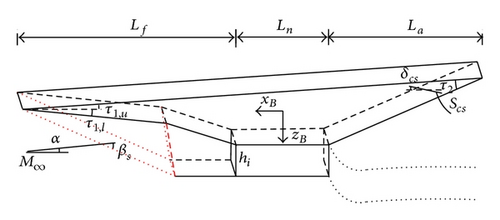
Besides these aerodynamic forces, the propulsive force is necessary to be estimated for establishing the parametric model, and the according propulsive structure is shown in Figure 2.
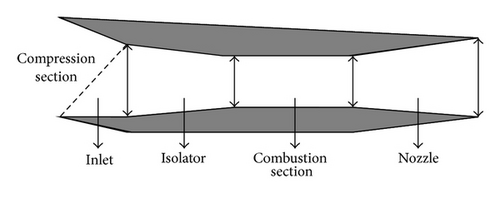

3. Collaborative Deformations Analysis and Control Law Design
Correspondingly, the overall study configuration is given for the collaborative deformation design in Figure 4.

Compared with the approaches and results in [20], this paper proposes a novel research process concerning the collaborative deformation design for the hypersonic waverider in Figure 4. This study includes the parametric modelling, model simplification, dynamic characteristic analysis, and control law design. In addition, the research contents in [20] aim to the control law design based on the control-orienting model using feedback linearization, and the control action can suppress the disturbance due to the elastic deformation which is passive and induced by the aerodynamic forces. By contrast, this paper presents a new idea that the active deformation and control action are both given for the hypersonic waverider to improve overall performance and guarantee flight stability through the large flight range. As a result, the collaborative deformation is required to realize the design goal for the hypersonic waverider.
4. Simulation Analysis
In the simulation, this paper uses the given geometric parameters of hypersonic waverider in [18], and the trim values due to the changes in lower forebody angle and elevon area are solved first to display the effect on static features with respect to the change in the different shape parameters. More importantly, the attention on the multivariable deformations is paid to discover the collaborative features associated with the different shape changes. Also, the control effectiveness is evaluated to guarantee overall stability in the morphing process.
Based on that, we first consider the change in the single shape parameter including the lower forebody angle and elevon area, and when the lower forebody angle changes from 3 deg to 6 deg, the change curves of the trim angle of attack and control inputs are provided in Figure 5.
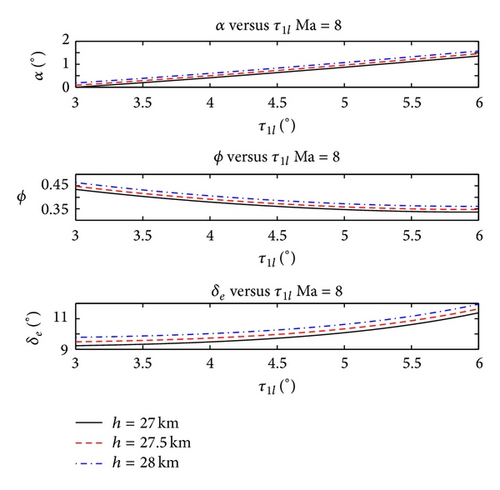
Figure 5 shows that the change in the lower forebody angle will have a significant influence on the trim angle of attack and control inputs. Not only that, when the elevon area alters, the change curves of the trim angle of attack and control inputs can be given in Figure 6.
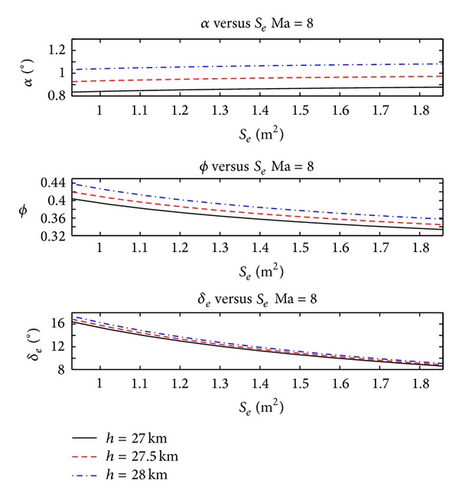
Figure 6 demonstrates the changes in the trim angle of attack and control inputs as the elevon area changes. We know that the according trends are converse in contrast to these provided in Figure 5. As a result, the collaborative deformation between the lower forebody angle and elevon area is necessary to consider, and the resulting relations are displayed in Figure 7.
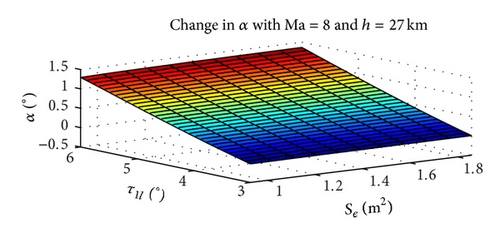
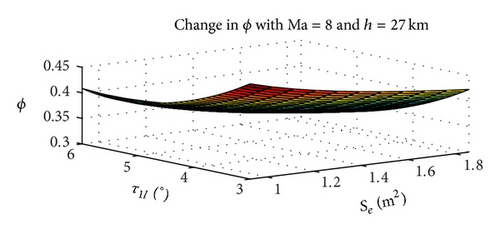
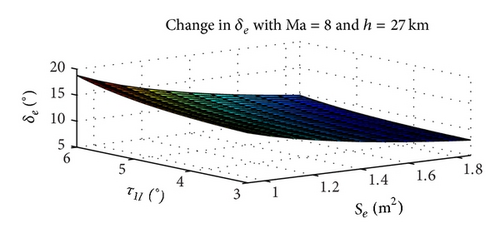
Figure 7 tells us that the collaborative deformation between the lower forebody angle and elevon area will guarantee the matching trim relations between the flight states and control inputs. For instance, the trim equivalence ratio in Figure 7 will become smaller as lower forebody angle is larger. This is because that the compressed airflow through the engine will be affected by the increment of the lower forebody angle as a result of changing the trim equivalence ratio. In this case, the trim elevon deflection angle will become larger such that the according static properties are worse. Therefore, the matching relationship can be acquired by coordinating the geometric deformations in relation to the lower forebody angle and elevon area.
Furthermore, the inversion control law is applied to ensure flight stability and realize the command track. In the simulation, the command signals include hc = h0 + Δh = 27.1 km and Vc = V0 + ΔV = 2477.8 m/s where h0 = 27 km and V0 = 2397.8 m/s. When passing 100 s, the response curves are provided in Figure 8.
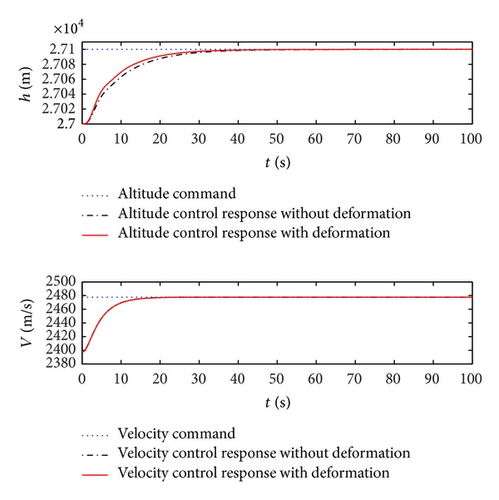
Figure 8 shows the outputs can follow the anticipated commands well on the conditions of with the collaborative deformation and without the collaborative deformation. These results indicate the response dynamics associated with the geometric deformation will become better than that associated with the fixed shape. Beyond this, the changes in the angle of attack and control inputs are given in Figure 9.
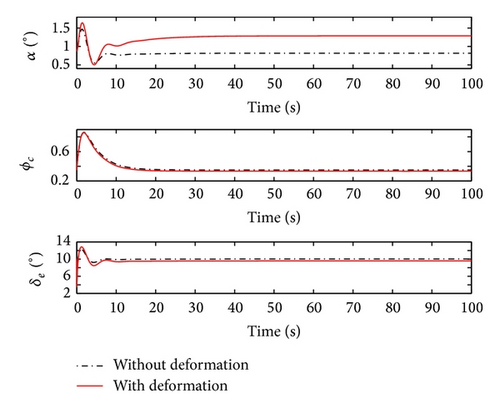
Figure 9 demonstrates the changes in the angle of attack and control inputs when considering the control action. From these results, we note that the collaborative deformation makes that the equivalence ratio and elevon deflection angle are both smaller than that using the fixed structure. This will provide the more control redundancy and save the more energy for hypersonic waveriders in the control process. Specifically, by conducting the active deformation, the angle of attack can maintain the expected value of 1 deg in order to meet the operation requirements of the scramjet.
5. Conclusion
This paper investigates the collaborative deformation design problems for the hypersonic waverider. Although the typical structure of a hypersonic vehicle is used, the active deformation is considered with the changes in the lower forebody angle and elevon area. In addition, a control-related design framework is proposed for analyzing the effectiveness of the collaborative deformation of the hypersonic waverider, and this framework involves the multidisciplinary approaches, including aerodynamics, propulsion, and control. Furthermore, a simulation example is given to demonstrate that the collaborative deformation design is necessary to acquire the satisfactory performance through the overall envelope for the hypersonic waverider. We believe this work will be helpful to develop novel aerospace vehicles in the future.
Conflict of Interests
The authors declare that there is no conflict of interests regarding the publication of this paper.
Acknowledgments
This work is supported by National Natural Science Foundation of China under Grant no. 61403191, the open funding project of State Key Laboratory of Virtual Reality Technology and Systems under Grant nos. BUAA-VR-14KF-03 and BUAA-VR-14KF-06, and Natural Science Foundation of Jiangsu Province under Grant no. BK20130817. The authors thank the editors and the reviewers for their help and improvements to the quality of our presentation.




